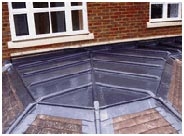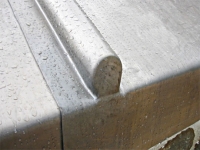
Lead Work
If lead work is to be properly detailed and fitted it is essential to have a good understanding of the nature and uses of the material, and to follow certain rules of good practice which have been developed from long, and sometimes costly experience.
Some of the common causes of failure, fault recognition and appropriate remedial action are explained together with an overview of the material's characteristic behavior.
Lead sheet, one of the oldest and most durable roofing materials, has been known to last for over two hundred years. Some lead sheet is still made by the original method of casting molten lead on a bed of sand. This cast lead sheet is produced by specialist firms and is largely used for replacing old lead sheet on cathedrals and churches where authenticity is important.
Originally manufactured on rolling mills and known as milled lead sheet, it began to replace cast lead sheet at the beginning of the 19th century, and today, nearly all the lead sheet used in building is in this form. Modern milled lead sheet is made to the specification laid down in British Standard 1178.
In more recent years, lead sheet - manufactured by the continuously cast method - has been introduced for roofing purposes in the UK

Repair Work
Small patches of lead sheet may be carefully welded over any splits to form permanent repairs. The lap joints should be used to strengthen and to prevent penetration of the flame through the lead. Roll ends are a common point of failure and the whole section may be cut out so that a new pre-fabricated roll end can be welded into position.
Precautions should be taken against the risk of fire when making repairs using a blow-torch. Where a hot working ban is enforced, repairs can only be made by either taking the defective panels out and welding patches off site, or sealing the cracks with a patent sealing tape. We do not normally recommend the latter because repair tapes do not usually last very long
The Characteristics of Lead Sheet Roofing and Flashing's
The characteristic behavior of lead sheet needs to be taken into account when designing or renewing details.
Thermal Movement
The main cause of failure is due to over sizing often coupled with over fixing. Lead sheet on buildings is usually fixed externally and is thus subjected to conditions of changing temperature. Lead has a high coefficient of linear expansion and when the difference between the winter and summer temperatures are taken into account the result of a simple calculation will show an increase in the size of the sheet. If thermal expansion and contraction cannot take place freely there will be a risk of distortion and stress which in time will cause the lead to buckle and crack. It is of first importance with lead sheet fixed externally, as with all sheet metals, to limit the size of each piece so that the relatively small amount of thermal movement is accommodated within the jointing and fixing details. Recommendations on the maximum sizes of pieces of lead sheet are shown in tables published by the Lead Sheet Association (LSA) and in the British Standard 6915 (2, 5 and 6).
It is also important that fixings should not restrict thermal movement but must be adequate to support the lead and, depending upon the degree of exposure, retain it in position. Bays on flat roofs should only be fixed at the top third of the roll under cloak only and on pitched roofs and cladding across the head under the lap joints. Copper retaining clips fixed within the joints should allow for thermal movement to take place and fixings along the free edges should hold the lead freely against wind lift.
Moisture Corrosion
In well heated buildings, it is possible for warm moist air to filter through to the roof structure and, unless prevented, condense on the inner face of the sheet lead. If there is insufficient air circulation to form a stable patina, corrosion of the lead sheet is probable. The usual signs of corrosion from condensation are white streaks running out from under lap joints (not to be confused with run-off stains), and a white powder forming under the lead. The corrosion process is sometimes advanced by the presence of oak timber or an organic fibre underlay.
Particular attention should be paid to the conditions inside the building and also within the roof structure itself. Moisture will migrate from one place to another beneath a roof decking. Regardless of a vapour barrier and dry site conditions during construction, condensation may still form on the underside of the lead sheet. This can never be accurately predicted and it is therefore recommended that a ventilated air space be detailed below the decking material.
Conclusion
Lead sheet is a reliable material. In the hands of a person trained and experienced in lead working skills it will not only enhance the aesthetic appeal of a building, but will keep the building dry for many years. There is a list of specialist lead workers available who are members of the Lead Contractors Association.
The technical officers in the Building Section of the LSA provide technical information and advice by telephone or by post and will comment on any drawings or specifications for lead sheet projects. When in doubt about any lead work details it is always best to obtain the latest information and advice. The Lead Sheet Association offers technical advice on all aspects of lead sheet use.

More Information
Preventing Corrosion
Lead sheet is resistant to most forms of corrosion likely to be encountered in a roofing situation, but certain precautions need to be taken against the following:
- Mortar: Unprotected lead damp proof courses and cavity trays may corrode in the presence of moisture
- Lichen Growth: The acid run-off from lichen or moss on a roof may cause small holes to appear in the lead sheet under the drip-off point from tiles or slates. A sacrificial flashing may be fitted to the lead gutter or roof, or the growth may be treated with a chemical fungicide
- Condensation: In certain conditions the underside of lead sheet may corrode and it is important to design the roof to reduce the risk of condensation and provide adequate ventilation
Support and Fixing Methods
Lead sheet must be adequately supported on a smooth base sufficient to take the weight and to allow for thermal movement to take place. It may be laid on timber, plywood, concrete or masonry together with a suitable underlay. The lead sheet should be held in position with fixings of a type, strength and position which:
- Support the weight of the lead sheet
- Are resistant to corrosion
- Allow for thermal movement to take place
- Resist wind uplift
Jointing Methods
Joints in leadwork are weathertight but not watertight. Joints in leadwork are designed to keep water out whilst allowing for thermal movement. It is therefore important that the type of joint used is appropriate for the type of application or situation.
Bossing, Welding, Jointing, Fixing, Corrosion Bossing and Welding Methods
Lead sheet should be carefully worked or welded so that the lead is not thinned by more than 25% or weakened by creasing or stretching. Bossing and welding lead should be carried out by experienced (preferably registered) operatives using the proper tools and equipment.
Properties of Lead Sheet Physical and Mechanical Properties of Lead Sheet
- Malleability - Lead is soft, malleable and capable of being manipulated with hand tools and, by the technique of bossing, can be worked into the most complicated of shapes or dressed to fit the many types of profiled roofing tiles.
- Fatigue and Creep Resistance - Attention to correct sizing and fixing of individual pieces minimizes any risk of fatigue cracking or creep. The chemical composition of rolled lead sheet is strictly governed by the provisions of BSEN 12588:1999, which effectively control the grain structure to make the lead sheet more resistant to thermal fatigue without affecting malleability
- Durability - When specified and fitted correctly, rolled lead sheet can continue to provide a maintenance free weather shield for 100 years. Rolled lead sheet is therefore extremely resistant to atmospheric corrosion
- Thickness - Thicker sheets may be required when dressing lead into deeply profiled tiles, in areas of frequent foot traffic, on flat roofs and gutters where extra rigidity is required to resist wind uplift and where thermal movement is likely to occur. Lead has a high linear expansion and this must be considered in the design, layout and sizing of panels
- Recyclability - Rolled lead sheet is totally recyclable. Scrap material is recovered from end of life buildings in the UK by a national network of reclamation merchants and channeled back to the manufacturers where it is carefully refined back to new feedstock for the rolling mills. The established recovery network, constant recycling of old material and low melting point with resultant energy efficiencies in manufacturing means the lead sheet industry has a solid reputation for environmental awareness and as a conserver of natural and energy resources
- Fire Resistance - Lead is incombustible but melts at 327.4°C.
Work Guarantee
All work undertaken by C. Stevens Roofing is covered by clear, written guarantees including workmanship and material, to give you added confidence. Our guarantee is backed by a long established reputation in the business and is respected and valued by works professionals throughout the county.
Insurance Guarantee

HomePro Insurance Backed Guarantees helping you to protect your investment. Although home improvement is one of the safest forms of financial investment, there is one pitfall that can be overlooked.
Most contractors issue a guarantee for the work they have undertaken, we are no different. However, thousands of contractors cease to trade each year.
If your chosen contractor ceased to trade HomePro will match the terms of the contractors original guarantee.
